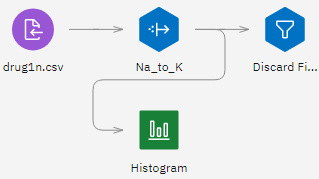Last updated: Oct 09, 2024
By exploring and manipulating the data, you have been able to form some hypotheses. The ratio of sodium to potassium in the blood seems to affect the choice of drug, as does blood pressure. But you cannot fully explain all of the relationships yet. This is where modeling will likely provide some answers. In this case, you will try to fit the data using a rule-building model called C5.0.
Since you're using a derived field, Na_to_K, you can filter out the original
fields, Na and K, so they're not used twice in the modeling
algorithm. You can do this by using a Filter node.
- Place a Filter node on the canvas and connect it to the Derive node.
Figure 1. Filter node 
- Double-click the Filter node to edit its properties. Name it Discard Fields.
- For Mode, make sure Filter the selected fields is selected. Then select
the
KandNafields. ClickSave. - Place a Type node on the canvas and connect it to the Filter node. With the Type node, you can
indicate the types of fields you're using and how they're used to predict the outcomes.
Figure 2. Type node 
- Double-click the Type node to edit its properties. Name it Define Types.
- Set the role for the
Drugfield to Target, indicating thatDrugis the field you want to predict. Leave the role for the other fields set to Input so they'll be used as predictors. Click Save. - To estimate the model, place a C5.0 node on the canvas and attach it to the end of the flow. Then click the Run button on the toolbar to run the flow.